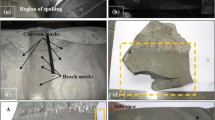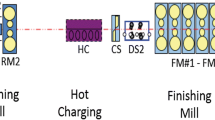Abstract
Although a precise understanding of roll failure genesis is complex, the microstructure of a broken roll can often unravel intrinsic deficiencies in material quality responsible for its failure. This is especially relevant in circumstances when, even under a similar mill-operating environment, the failure involves a particular roll or a specific batch of rolls. This paper provides a microstructural insight into the cause of premature breakage of a second-intermediate Sendzimir mill drive roll used at a stainless steel sheet rolling plant under the Steel Authority of India Limited. Microstructural issues influencing roll quality, such as characteristics of carbides, tempered martensite, retained austenite, etc., have been extensively studied through optical and scanning electron microscopy, electron-probe microanalysis, image analysis, and x-ray diffractometry. These are discussed to elucidate specific microstructural inadequacies that accentuated the failure. The study reveals that even though retained austenite content is low (6.29 vol%) and martensite is non-acicular, the roll breakage is a consequence of intergranular cracking caused by improper carbide morphology and distribution.
Similar content being viewed by others
References
S.G. Manganello and D.R. Churba, Roll Failures and What to Do When They Occur,Iron Steelmaker, Vol 7 (No. 12), 1980,p 26–34
D. Mukherjee, A. Ray, and S.K. Bhattacharyya, Spalling Resistance of Forged Steel Cold Rolling Mill Rolls: A Microstructural Insight,Mater. Forum, Vol 16 (No. 4), 1992, p 317–325
G.A. Roberts and R.A. Cary, Class 520 Chromium-Molybdenum Hot Work Die Steels,Tool Steels, American Society for Metals, 1980, p 578–593
V.A. Kortesoja, Selection of Material for Rolls for the Metal-working Industry, Properties and Selection of Tool Materials, American Society for Metals, 1975, p 254–263
A.J. Bill and H.C. Scriven, Sendzimir Mills for Cold Rolling in BSC Stainless,Flat Rolling A Comparison of Rolling Mill Types, The Metals Society, 1979, p 163–169
M.G. Sendzimir, Sendzimir Mills and their Rolls,31st Mechanical Working and Steel Processing Conference Proceedings, Vol XXVII, The Iron and Steel Society, 1990, p 329–334
A. Gulayev, High-Speed Steels,Physical Metallurgy, Vol 2, Mir Publishers, 1980, p 87–101
Y. Geller, Carbide Inhomogeneity, Tool Steels, Mir Publishers, 1978, p 197–214
M. Nakagawa, A. Hoshi, A. Asano, and Y. Nambu, Causes and Countermeasures of Spalling of Cold Mill Work Rolls,Iron Steel Eng., Vol 58 (No. 3), 1981, p 44–49
C. Gaspard, P. Cosse, and A. Magnee, Contribution of ESR and Progressive Induction Hardening to the Manufacture of Deep Hardened Work Rolls,26th Mechanical Working and Steel Processing Conference Proceedings, Vol XXII, The Iron and Steel Society, 1985, p 75–87
W.F. Smith, Hot-Work Tool Steels,Structure and Properties of Engineering Alloys, McGraw-Hill Book Company, 1981, p 382–386
W. Patt, Production and Properties of High-Cr-Rolls and Their Behaviour in Cold Strip Mills,26th Mechanical Working and Steel Processing Conference Proceedings, Vol XXII, The Iron and Steel Society, 1985, p 101–107
Author information
Authors and Affiliations
Rights and permissions
About this article
Cite this article
Ray, A., Mukherjee, D., Sarkar, B. et al. Influence of microstructure on the premature failure of a second-intermediate sendzimir mill drive roll. JMEP 3, 649–656 (1994). https://doi.org/10.1007/BF02645263
Issue Date:
DOI: https://doi.org/10.1007/BF02645263




